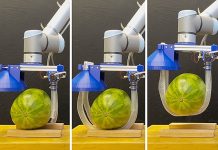
Have you ever heard of a robot made of wood?
Well, scientists from Singapore and China have just developed one that could change the future of robotics. It’s not just any robot, but a wooden robotic gripper.
You may be thinking, “How does that work?” Keep reading to find out more!
Robots usually use hands, called grippers, made from metal or plastic to hold and move things.
But these materials have issues. Plastic can melt in high temperatures, and metal is both hard and expensive.
However, these scientists have found a solution. They’ve made a robotic hand out of wood! And not just any wood, but super-thin slices of Canadian maple wood.
What’s super cool is that this wooden gripper moves when the weather changes. If it’s really humid (which means the air is very wet), the gripper opens up.
When the temperature gets hotter than 70°C or when exposed to sunlight, the gripper closes up.
This could make the wooden gripper great for use in very hot environments and reduces energy consumption because it doesn’t need the power to move; it just reacts to the environment.
To make the wooden gripper work, the scientists treated the wood with a substance called sodium chloride, which is just a fancy name for table salt.
This gets rid of a part of the wood called lignin. Then, they filled the wood’s pores with a polymer (a type of large molecule) named polypyrrole. This helps the wood to easily absorb heat and light.
Next, they coated one side of the wood with a special gel that loves to absorb moisture, and they attached a film that hates water on the other side.
This difference between the two sides causes the wooden gripper to change its shape when it comes in contact with humidity or lots of moisture in the air.
What’s even more amazing is that this wooden gripper can pick up heavy objects even in really hot temperatures.
For example, it could lift a can of soda at a temperature as hot as 170°C. That’s way hotter than the highest setting on your oven!
Scientists are now planning to improve the wooden gripper so it can carry even heavier objects, grip things of different shapes and sizes, and move more quicker. They’re also working to make it cheaper and easier to produce.
One day, this clever wooden robot hand might even help firefighters during rescue operations.
So, there you have it! Robots are not just about metal and plastic anymore. Wood, too, can be a part of our robotic future. Isn’t that neat?
The study was published in Advanced Materials.



